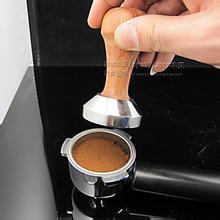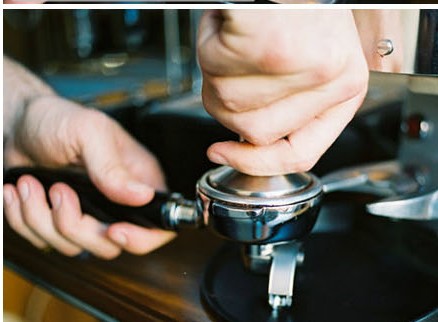Introduction to the course of making Italian Coffee: an introduction to the elements that should be paid attention to in the production of pressing Powder by Espresso

Previous blog posts have introduced various factors that affect the taste of Espresso. Here is a further summary of only one of these factors, which is also a very important step in the process of making Espresso. What is assumed here is the ideal state, leaving aside other factors, powder quantity, water temperature, grinding degree, humidity, water pressure, etc., and only consider the influence of powder pressing action and the elements that powder pressing should pay attention to.
Generally speaking, the process of pressing powder can be divided into two steps, first pressing once, gently tapping the edge of the powder bowl, and pressing powder for the second time. This is now a more common way of pressing powder (of course, there are other ways). The effect of pressing powder is that pressed powder is tight, and the surface of pressed powder is flat and horizontal. How can such a result be achieved? In addition to the need for many exercises, the two steps of powder pressing are also required.
The first time you press the powder, you need to press it gently. Some say it is heavy pressure, in order to make the coffee powder compact to form a good pressed powder foundation. First of all, heavy pressure can indeed form a good pressed powder foundation (just like laying a foundation, you must have a good foundation before you can build a solid house). But the heavy pressure also has a downside: if the heavy pressure is not well controlled, the surface of the basic coffee pressed powder is likely to be not flat but inclined, so that no matter whether your second powder pressing is light pressure or heavy pressure, you can not correct such noodles. Second, after the first heavy pressure, only a foundation is formed, but the interior is not the most ideal compact state (otherwise only this time pressing powder is enough, and the rest of the action is superfluous), so if light pressure is used when pressing powder for the second time, it is difficult to exert enough influence on the internal coffee powder, if heavy pressure is used, it will destroy the foundation that has been formed, and is not conducive to meeting the requirements of pressed powder. And the first time to press the powder to take light pressure, will reduce these bad effects. With a little pressure, the coffee powder becomes a little tighter, so that the surface of the coffee powder becomes smooth.
The act of tapping a powder bowl between pressing powder. The main purpose of this action is to make the coffee powder adhere to the inner wall of the powder bowl fall down (otherwise, when making the extraction, these powders can easily be soaked and stuck to the inner wall of the outlet head, forming black dirt over time). Some people are used to knocking many times, some people are accustomed to knocking on the lower part of the powder bowl, and some people are used to knocking hard at once, which are all bad. First of all, the coffee powder just adheres to the inner wall and can be dropped by tapping it gently, so there is no need to hit it many times or use a lot of strength. Second, although tapping on the bottom of the powder bowl can also make the coffee powder fall, this action can also have a more serious bad effect-- making the internal coffee powder move. Pressed powder, which has been slightly tightened by light pressure (although it may not be visible on the surface), it is difficult for the powder to correct such a mistake. Therefore, the action of tapping should be gentle, and it is best to control the number of knocks within three times along the edge of the powder bowl.
The second pressing powder requires heavy pressure. The coffee powder which has been lightly pressed in front has formed a relatively compact pressed powder, so it needs to be pressed further to meet the compaction requirements of pressed powder required by the production of Espresso coffee. The reason why it is not suitable for light pressure is that the compactness of light pressure pressed powder is not enough to produce rich and mellow espresso. But there are requirements for stress. The heavy pressure is to make the coffee powder more compact and the noodles should be kept horizontal, so the pressure should be big. But the force should also be uniform, otherwise the flour will tilt, or it may look horizontal on the surface, but in fact, the density of the whole pressed powder is inconsistent (some coffee powder is large and compact, in some places coffee powder is less but relatively loose) this will also affect the next step of production and extraction. So the second time to press the powder with heavy pressure, at the same time pay attention to the uniform force (the thumb and index finger can be placed on the upper edge of the powder hammer to touch the upper edge of the powder bowl, according to which it feels like a uniform force). In order to achieve the ideal state, the pressure is generally controlled at three to four times is the best. Some people are used to pressing hard and then rotating the powder hammer to achieve the effect of multiple heavy pressure, but this is a very bad habit. The powder hammer can be rotated between three to four times to sense the overall pressed powder level with the thumb and index finger, but do not press hard during rotation. The rotation with pressure can easily drive the pressed powder to move slightly together, which can easily cause the pressed powder to not combine closely with the edge of the powder bowl, and cracks will appear inside the pressed powder, which will give a relatively loose channel for hot water, resulting in the failure of the final coffee.
Pressing powder is the biggest factor in the production of Espresso that can be controlled by manpower in addition to adjusting the degree of grinding. Making Espresso after this step will make it easier to analyze the causes of the bad situation (because it excludes the most uncertain factor of human error). It takes a lot of practice to form good habits.
Of course, this is only one of the many ways to press powder, and it is not the only correct way. Constantly practicing and summing up, finding the most suitable way is the most important.
Source:
Happy Coffee Xiao Xu's blog
Important Notice :
前街咖啡 FrontStreet Coffee has moved to new addredd:
FrontStreet Coffee Address: 315,Donghua East Road,GuangZhou
Tel:020 38364473
- Prev

Introduction to the course of making espresso: a detailed introduction to the strength of pressing powder made by Espresso
Powder pressing is a very important step in the manufacturing process of Espresso. We have already talked about the importance and requirements of pressing powder. So is the use of pressing powder as strong as possible? What does the power of powder pressing have to do with it? Theoretically speaking, with the difference of the thickness of the coffee powder, that is, the grinding degree of the coffee powder, the force of the pressing powder should be adjusted accordingly. The coarser the coffee powder is ground
- Next

Key points of hand-brewing technique for coffee brewing
Steaming is a very important link in the process of making hand-brewed coffee. Good steaming can fully infiltrate the coffee powder and activate the coffee activity, thus making the coffee extraction process more smooth. So how to do a good steaming? Steaming literally means to cover the ground coffee powder with a lid and let it react in it to facilitate later production.
Related
- What is the meaning of lactic acid fermentation with coffee bean treatment?
- How to judge the state of foam by sound?
- How does the latte pull out the unicorn pattern? Come to get for a little trick to improve the flower pull!
- Will flower pulling affect the taste of the latte?
- Do you know the history of coffee?
- The difference between honey treatment and sun washing what is raisin honey treatment?
- What kind of milk can a novice use to make coffee foam to keep the foam longer? The correct method and skills of milking tutorial sharing
- Why do washed coffee beans taste sour? Flavor characteristics of washed Coffee
- Introduction to the skill of how to practice the size and height of water injection around the circle of hand-brewed coffee
- How do beginners practice coffee flower drawing from scratch?

